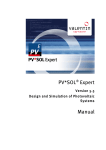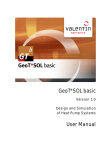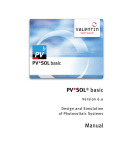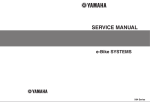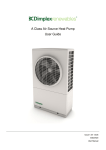Download Hinweise zur Planung von Solarstromanlagen
Transcript
T*SOL express Simulation programme for the quick design and calculation of solar thermal systems User Manual The information contained in this manual is without warranty. The programme developers assume no responsibility for its contents. The software described in this manual is distributed in accordance with the terms of the licence agreement which are accepted on installation of the programme. Liability claims are excluded. The reproduction of any part of this manual is prohibited. COPYRIGHT © 2006: Dr.-Ing. Gerhard Valentin Dr. Valentin EnergieSoftware GmbH Stralauer Platz 34 10243 Berlin Germany Tel: Fax: Internet: E-Mail: +49 (0)30 588 439 – 0 +49 (0)30 588 439 – 11 www.valentin.de [email protected] T*SOL express User Manual Contents 1. Introduction......................................................................................3 1.1. Programme Information......................................................................................... 3 1.2. Solar Thermal System Basics ............................................................................... 4 1.3. Computer System Requirements.......................................................................... 8 1.4. Programme Installation ......................................................................................... 8 1.5. Programme Activation ........................................................................................... 9 1.5.1. Enter the Serial Number..................................................................................... 10 1.5.2. Request a Key Code .......................................................................................... 11 1.5.2.1. Request a Key Code Online........................................................................... 11 1.5.2.2. Request a Key Code by E-Mail ...................................................................... 12 1.5.2.3. Request a Key Code by Fax .......................................................................... 12 1.5.2.4. Request a Key Code by Telephone ............................................................... 12 1.5.3. Enter the Key Code ............................................................................................ 12 2. General Programme Structure .....................................................13 2.1. Welcome Page ...................................................................................................... 13 2.2. Moving Around the Programme.......................................................................... 14 2.2.1. Navigation Area .................................................................................................. 14 2.2.2. Programme Control Area ................................................................................... 15 3. Creating Projects with T*SOL express ........................................18 3.1. Example Project.................................................................................................... 18 3.2. Start ....................................................................................................................... 19 3.3. System Hydraulics ............................................................................................... 23 3.4. Domestic Hot Water (DHW) ................................................................................. 24 3.5. Space Heating Requirement................................................................................ 25 3.6. Collector Array...................................................................................................... 26 3.7. Design.................................................................................................................... 28 3.8. Results................................................................................................................... 29 4. Attachment.....................................................................................32 4.1. Glossary ................................................................................................................ 32 © 2006 Dr. Valentin EnergieSoftware GmbH 2 T*SOL express User Manual 1. Introduction 1.1. Programme Information T*SOL express is the quick and easy design programme for solar thermal systems. It is the right choice for sales staff and trade technicians who need a reliable tool to design solar thermal systems quickly and precisely. A number of different systems can be selected for hot water supply and space heating. The programme is user-friendly, taking you through a few simple steps with clearly laid-out dialogues, allowing you to work quickly and efficiently. With T*SOL express you can use the symbols in the simple navigation bar to go directly to the corresponding position in the programme. You can also use the Continue and Back buttons to work through the programme from start to finish, so that you don't miss any entries. T*SOL express offers you a selection of 5 different systems for calculation. For hot water supply, there is a thermosyphon system, a bivalent (twin coil) system with one storage tank and a two-tank system with a solar and stand-by tank. Systems with space heating can be calculated with a combination tank system and a solar buffer tank system. T*SOL express is a reliable planning tool which calculates the collector area and storage tank volume, so that dimensioning errors are avoided. The required number of collectors, selected from five different collector types, is determined by inputting the hot water requirement or the number of people in the household. T*SOL express has a large selection of climate data for locations in Europe and worldwide. After entering the inclination and orientation, a detailed yield calculation is carried out for the selected system components. The calculation is based on the calculation algorithms in T*SOL®. T*SOL express produces a simple project report for your customers with clear presentation of the system data and results, as well as a system overview. The report can either be printed out or sent as an e-mail attachment in pdf format. © 2006 Dr. Valentin EnergieSoftware GmbH 3 T*SOL express User Manual 1.2. Solar Thermal System Basics With an increase in building insulation, leading to a decrease in the energy requirement for space heating, the proportion of energy needed for hot water supply is increasingly important for the total energy requirement. Solar thermal systems can play an important part in producing this energy requirement. Today’s solar hot water systems function very reliably and make it possible to reach an annual energy yield of 350-500 kWh per square metre of collector area. At the same time, they avoid approximately 100-150 kg of the greenhouse gas CO2. Solar thermal systems use the sun’s radiation, directly converting it on an absorbent surface into heat, which can be utilised particularly in the area of hot water production. A solar thermal system should fulfil the following tasks: • • • Convert the irradiated energy from the sun into heat via the collectors Transport the heat to the storage tank through the piping Store the heat in the buffer tank until the hot water is required. During this process, energy losses occur in the collector, in the piping and in the hot water storage tank. The appropriate system design and planning for each type of use is important for minimising these losses. The System Efficiency assists in judging the extent of these losses. This is defined as the quotient of the energy generated by the solar system and the energy irradiated onto the collector surface (active solar surface). The part of the total energy that is produced by the solar system is known as the Solar Fraction. Principle Parts of a Solar System The Collector or Absorber is the fundamental element in a solar thermal system. This converts the solar energy into heat and transports it, using a heat carrying medium via the piping and heat exchanger, to a storage tank. For hot water systems, the storage tank balances out the daily fluctuations in energy supply and use. For large-scale systems, which are designed to make a considerable contribution to the production of space heating, a seasonal underground storage tank is usually included in a district heating system, to balance out the difference in radiation levels and the energy requirement over the year. However, these seasonal supply systems are still at the test phase and are therefore not observed here. © 2006 Dr. Valentin EnergieSoftware GmbH 4 T*SOL express User Manual If the levels of energy from the sun are not sufficient, an auxiliary heating system is used to make up the shortfall. A control system monitors the operating conditions in the solar system and ensures that the available radiation is utilised as efficiently as possible. This system switches on the collector loop pump if there is a temperature difference between the storage tank and collector, thus providing for the transport of heat to the storage tank. Absorber / Collector Function Black surfaces absorb the short-term radiation from light particularly well, converting it into heat. This physical characteristic is used in the so called absorbers. They are made of plastic or metal in the form of sheets, mats or tubes with a black surface, which is galvanised or otherwise treated, according to the quality of the absorber. Absorbers are the active element in a solar system. There are two different systems, depending on the type of use and the level of temperature required: • • Absorber Systems and Collector Systems. Absorber Systems do not have any kind of insulation or covering and a heat carrying medium flows directly through the system. These are simply constructed, inexpensive systems which are suitable for working temperatures below 40°C. The main uses for this type of system are heating swimming pool water and preheating domestic hot water. Absorber mats, which are usually made of plastic, can be placed at any stage onto flat roves or low-pitched roves quite simply in terms of the building work required. Collector Systems with Flat-Plate Collectors have an absorber (mostly made of metal) in a sealed housing which has a transparent cover and heat insulation at the back. The transparent cover reduces the radiation from the absorber to the environment and the heat insulation reduced the heat losses at the back of the collector, so that temperatures in excess of 150°C can be reached. This type of system is mostly used for domestic hot water supply and the support of space heating. Flat-plate collectors are available in a variety of sizes from 1-10 m². Special shapes are also available (e.g. triangles). These collectors are integrated into the roof or fixed onto the roof in ready-made modules and connected to each other. Collector Systems with Evacuated Tube Collectors contain metal absorbers which are housed in glass tubes. The vacuum ensures that the heat losses are kept to a minimum, so that temperatures of 200°C can be reached. This type of system is mostly used for domestic hot water supply, the support of space heating and process heat production, as well as solar cooling in buildings. © 2006 Dr. Valentin EnergieSoftware GmbH 5 T*SOL express User Manual Storage Tank Function The storage tank serves, as in every domestic hot water system, to balance out the peak periods of use and the available load for hot water supply. For solar systems it also balances out the difference between the periods that the sun’s energy is available and the periods that the hot water is required. The lower part of the storage tank usually contains a heat exchanger, in which the medium from the collector (mostly a mix of water and glycol) transfers the solar energy from the collector to the contents of the storage tank. If required, the upper part of the storage tank can be additionally heated by a conventional heating system, so that the hot water taken from the upper part is maintained at the desired temperature, independently from the amount of solar energy available. Large-scale systems include a number of storage tanks connected to each other, with the last tank connected to the auxiliary heating. Control Function Solar systems normally use a so called temperature difference control. With this control method, the absorber and storage tank temperatures are compared. If the absorber temperature reaches a given amount above the storage tank temperature, the collector loop pump is automatically switched on. The solar energy which has been converted to heat by the absorber system is transported to the storage tank and the temperature in the tank increases. If the tank temperature equals the absorber temperature, no further energy can be transferred to the storage tank and the circulation pump is switched off. Sizing Solar Systems Small systems in family houses are usually designed so that, in the period when space heating is not required, full supply can largely be reached and in summer the boiler does not have to be used. In this way, approximately 60% of the annual hot water requirement can be covered by solar energy. On the other hand, if you want more hot water to be supplied by the solar system in between seasons or in winter, larger solar fractions will produce excess energy in summer which cannot be used. The solar system no longer works as effectively as possible. This means that an increase in the solar fraction leads to a decrease in efficiency of the solar system. For systems in larger buildings (e.g. hospitals) where it is not possible to switch off the auxiliary heating completely in summer, solar systems are today designed with a solar fraction of up to 30%. There is no simple method of calculation to exactly determine the yields of a solar system. The number of parameters which determine a system’s operating © 2006 Dr. Valentin EnergieSoftware GmbH 6 T*SOL express User Manual behaviour is simply too great. Not only the fluctuating, non-linear behaviour of the weather needs to be taken into account, but also the dynamic processes within the system itself. For larger systems, only a computer simulation can offer a reliable method of investigating the many influences, including environmental conditions, the behaviour of system users and the different components, on the solar system’s operating conditions. Solar systems can also be used for heating purposes – where space heating is also required in summer or where solar energy can be used for cooling purposes in summer. An additional area for solar systems to be used in future is in the support of space heating in low-energy houses. These have proportionately the same requirement for space heating as for the hot water supply. For buildings with the insulation standard normal for today, it would not be advisable to try and design solar systems with space heating in winter without the possibility of seasonal storage. This would result in over-sized collector areas and at the same time higher excess energy in summer, resulting in systems with extremely low efficiency and therefore higher solar heating prices. Economic Efficiency of Solar Systems Nowadays, solar systems are always bivalent systems, as they can never take over the heating energy supply alone, at least not for the entire year. They are therefore connected to the usual systems and function as fuel savers, more or less supplying pre-warmed water to the system for further heating. The economic efficiency of a solar thermal system takes into account the investment costs, the life span of the system, the interest on capital and a figure for service and operating costs. In relation to the amount of energy produced annually, this gives the Cost of Solar Energy in, for example, Cent/kWh. The Cost of Solar Energy for a kilowatt hour produced by the solar system is roughly at the same level as the production of hot water from electricity – and for lager systems it is now considerably lower. This development will over the next few years both drive on and simplify the use of solar thermal systems in multi-storey apartment blocks. © 2006 Dr. Valentin EnergieSoftware GmbH 7 T*SOL express User Manual 1.3. Computer System Requirements Hardware • • • • • • Pentium II 266 MHz 128 MB RAM 24 MB free on your hard disk drive Additional space on your hard disk drive for the meteorological data - up to 94MB for full installation CD-ROM drive 1024x768 screen resolution Operating System (with the latest service pack) • • Windows 2000 Windows XP System Requirements: • • 1.4. Internet Explorer 5.01 or higher Data Access Components (MDAC) 2.8 Programme Installation To install the programme put the programme CD into your computer’s CD drive. The installation programme will start automatically and you will be taken through the installation procedure step by step (unless the CD drive autorun function has been deactivated on your computer). If the autorun function has been deactivated, you will need to start the “Setup.exe” file which is on the CD. To do this you can start File Manager or Explorer and double click on the “Setup.exe” file in the CD drive. If you install T*SOL express onto a computer with WIN2000 or WinXP, you will need to have administrator access to the operating system. To run the programme, you will need to have full rights (read and write) to the T*SOL express programme directory (e.g. C:\Programme\Valentin EnergieSoftware\TSOLexpress 1.0). © 2006 Dr. Valentin EnergieSoftware GmbH 8 T*SOL express User Manual 1.5. Programme Activation After installing and opening the programme, a small window appears asking whether you wish to start the programme as a Demo Version or Register the Full Programme. This dialogue appears every time the programme is started, until you have activated the programme successfully. The Demo Version gives you the opportunity to test and familiarise yourself with the programme. However, you are not able to save any projects or print the results. Once you have activated/registered the software, all programme functions will be fully available to you. You can also carry out the registration procedure from within the programme. To do this, click on the Info button in the lower programme control bar and then on the Registration tab. You can also use this option after you have already registered T*SOL express and want to activate an update. Programme Activation is carried out by following the instructions, requesting a Key Code and then entering it in the programme. The Key Code is provided by the programme manufacturer on request. First you will need to make sure that: • You have a Serial Number • The programme has already been installed • When you start the programme, you click on the License Full Version button Programme Activation is carried out in four steps: • Enter Serial Number • Programme ID is Allocated © 2006 Dr. Valentin EnergieSoftware GmbH 9 T*SOL express User Manual • • Request Key Code Enter Key Code The corresponding dialogue introduces the registration procedure. Click on Continue to start the registration procedure. 1.5.1. Enter the Serial Number If you purchased the programme from the manufacturer, you will already have a Serial Number. You will find this on the CD cover, on the invoice or we will have sent it to you by e-mail. The Serial Number has the following format: 12345-123T-123-1NN-1-VW2R-RY-Z62-AGNH1 It needs to be entered exactly as it appears, including all character and without any spaces. After the Serial Number has been entered, the programme allocates a Programme ID, which is based on the Serial Number and a code for your PC. You Still Don’t Have a Serial Number? This could be the case if, for example, you have installed the programme from the Demo CD or you have downloaded it from the internet. You will need to purchase a full version of the programme before you can receive a Serial Number. © 2006 Dr. Valentin EnergieSoftware GmbH 10 T*SOL express User Manual Send us the Order Form which you can print within the programme under Info/Registration, or you can purchase the programme direct from the OnlineShop on our website. You’ve Purchased the Programme and Can’t Find Your Serial Number? No problem. Send us the invoice for the programme with your contact details and we will send you the Serial Number again. 1.5.2. Request a Key Code After entering the Serial Number and automatic allocation of the Programme ID, you will need to provide us with this information, so that we can send you your Key Code. You will see the following window on your screen: You can request the Key Code in a number of different ways, but the quickest way to do this is online. 1.5.2.1. Request a Key Code Online This is the simplest and quickest method, requiring that your computer has internet access. Click on the Online button underneath Programme ID in the Registration window. A form opens in which you enter the data required to obtain a Key Code. The fields marked: * have to be completed to continue. The serial number and programme ID are included automatically. © 2006 Dr. Valentin EnergieSoftware GmbH 11 T*SOL express User Manual After completing the form, you can send it straight off to the programme manufacturer via the internet. You will receive the Key Code in just a few minutes. It will be sent to the e-mail address entered on the form. 1.5.2.2. Request a Key Code by E-Mail If, on the other hand, you click on the E-Mail button in the Registration window, this will open your e-mail programme. The text in the e-mail is almost complete – you just need to enter your customer details and send the e-mail. You will then receive the Key Code by e-mail, normally within a day. The code will be sent to the e-mail address entered on the form. 1.5.2.3. Request a Key Code by Fax If you click on the Fax button underneath Programme ID in the Registration window, a form opens for you to complete and print off. Send the completed form by fax to: +49 30 588 439 11. You will then receive the Key Code by fax within one working day. You can also enter an e-mail address to which the Key Code should be sent. 1.5.2.4. Request a Key Code by Telephone If you do not have a fax or e-mail/internet access, you can request a Key Code by telephone. In this case, you will need to give the Serial Number and the Programme ID over the phone. 1.5.3. Enter the Key Code Once you receive the Key Code, you will need to enter it by hand or copy and paste it into the field under “Enter Key Code” in the Registration window and then click on the “OK” button. This completes the programme registration and activation procedure. An information window appears with a message that registration has been completed and the programme is now fully functional. © 2006 Dr. Valentin EnergieSoftware GmbH 12 T*SOL express User Manual 2. General Programme Structure 2.1. Welcome Page The Welcome page opens automatically when you start the programme. This page contains a general description of the programme. Click on the User Manual link to open the manual (pdf file). You can click on the corresponding icon to find out more about the extensive solar thermal simulation programme T*SOL Professional. The link will take you to the detailed information on the Valentin Energy Software website. © 2006 Dr. Valentin EnergieSoftware GmbH 13 T*SOL express User Manual 2.2. Moving Around the Programme The programme window is divided into different areas, to help you move around the programme quickly and easily. 2.2.1. Navigation Area The left-hand side of the programme window contains the active icons, so that you can move directly to a particular page. This part of the programme window is the Navigation Area. Click on the icons to go to the page selected from any part of the programme, whether before or after the page you are currently on. © 2006 Dr. Valentin EnergieSoftware GmbH 14 T*SOL express User Manual 2.2.2. Programme Control Area There are a number of other buttons at the bottom of the programme window in the Programme Control Area (and to the right of this area) to help you use the programme. Click on Continue and Back to move to the next or previous page. This allows you to work systematically through each page of the programme, without missing any entries. Click on Settings to open a window where you can enter and change the settings for your projects and select the programme language. You can select the settings for the climate data record, the collector type and enter various other system parameters on the Design tab sheet. These settings appear automatically in the programme each time you open a new project. You should use this facility to define the parameters that you generally use as standard. You can also set the Solar Fraction for your system designs here. To select the Programme Language, use the drop-down menu to select one of the languages available. © 2006 Dr. Valentin EnergieSoftware GmbH 15 T*SOL express User Manual You can enter your company data on the Project Report tab sheet. These details then appear automatically when you print your project results. You only need to enter these details once and they are adopted for all the projects that you work on, as long as the data is not changed. The details appear in the project report header. In addition to your company name and address, you can also include your company logo. Click on the Load Logo button to select the logo you want to use, as you are accustomed to in Windows. The logo must be in bitmap file format (*.bmp). © 2006 Dr. Valentin EnergieSoftware GmbH 16 T*SOL express User Manual Click on the Info button to the right of the Programme Control Area to take a look at the general information on your programme, such as the version number, and details on your hardware and operating system. You can also register your software from here. Select the tabs at the top of the Info window to get to the corresponding sheet. On the Further Information tab sheet you will find a Mail button, which you can use to send a query to the Valentin hotline. When you click on this button, your email programme will open automatically. All the information that we require in addition to your hotline query are already entered in the text area. You serial number and key code are included on the Registration tab sheet, provided that the programme has been activated. You can also change or renew the registration by clicking on the Change Registration button. Click on the Help button to the right of the Programme Control Area to open the help text for the programme page that you are currently on. You can use the navigation area in the help window to go direct to other help texts, or you can use the Index or Search tabs to search for particular texts. Click on the Exit button to the right of the Programme Control Area to close the programme. A message window usually appears asking whether you want to save the current project. © 2006 Dr. Valentin EnergieSoftware GmbH 17 T*SOL express User Manual 3. Creating Projects with T*SOL express 3.1. Example Project Here we will use an example project to illustrate how you set up a project in T*SOL express. This example project is also saved within the programme. The data that you require to create the example project are as follows: Project Name: Climate File: Design System: Building: Insulation Standard: Type of Collector: Roof Angle: Orientation (Azimuth): Length of Piping: Target Solar Fraction: Combination System in Sonnenheim Würzburg Combination system for DHW and space heating Detached house, 160 m², 6 residents EU Directive 2002/91/EC Flat-plate collector 55° -10° east from the south 10 m 20% First of all, you want the programme to determine the size of the storage tank and the required collector area for the above example project data. Then, by carrying out a simulation over the period of one year, the programme will calculate the energy yields, the primary energy savings and the CO2 emissions avoided. If you are still on the Welcome page, click on the Continue button to the right of the Programme Control Area, or click on the Start icon in the Navigation Area. © 2006 Dr. Valentin EnergieSoftware GmbH 18 T*SOL express User Manual 3.2. Start You can either create a new project or open an existing project on this page. You should enter an easily recognisable name for the project that you wish to create, so that you can easily find the project later on, when you want to work on the project again or make any changes. The name that you enter will be automatically saved as the file name. Projects are either saved to the default directory called projects, or to another directory if you prefer. All projects saved have the file ending *.tva and are normally saved in the following programme directory: C:\ Documents and Settings\ ...\ Own Files\ Valentin EnergieSoftware\ TSOLexpress 1.0\ projects. Type in a name, e.g. Combination System in Sonnenheim. If you select Load Existing Project, you can open a project that has been previously created and saved. Click on Search to get to the directory where your files are saved and look at the list of existing projects. Select a project, e.g. Combination System in Sonnenheim. Click on the Customer Data button to open a dialogue where you can enter and change the contact details for the project customer. © 2006 Dr. Valentin EnergieSoftware GmbH 19 T*SOL express User Manual If you select Adopt into Project Report, the customer information will be included in the project report. You also select the climate data for the project location in the Start dialogue. Click on Select to open an extensive list of climate data records from Germany and other countries – depending on which data records you selected when the programme was installed. The postal codes, longitudes and latitudes will help you to find the data record closest to the project location. After clicking on the Select button, you will see the following list: © 2006 Dr. Valentin EnergieSoftware GmbH 20 T*SOL express User Manual If you have installed climate data for a number of countries, you can first select the country from the Country Selection field at the top of the dialogue. When you have selected a country, only the data records for that country will be shown. For our example project, select Germany. Click on a column heading to sort the database either by city, postal code, longitude or latitude. This will help you to find the data record closest to the project location. Click again on the same column to sort in the opposite direction. If you type in the first character of the text you want to find in the column that has been selected, you will jump direct to the first entry with this character. © 2006 Dr. Valentin EnergieSoftware GmbH 21 T*SOL express User Manual Sonnenheim is located, for example, close to Würzburg. Therefore you should click on the Location column heding and enter a “w”. The first location starting with the letter “w” is then shown. Move down and select Würzburg and then click on OK. Alternatively, you can click on the Postal/Zip Code column heading to sort by postal code. Type in “9” and the first location that has a postal code starting with “9” is selected. Click on OK to accept the data record into the project and return to the Start page. To go on to the next stage, click on Continue or use the next icon in the Navigation Area on the left. © 2006 Dr. Valentin EnergieSoftware GmbH 22 T*SOL express User Manual 3.3. System Hydraulics The System Hydraulics page allows you to select a system configuration for your project. There are three systems for domestic hot water supply and two systems for domestic hot water supply and space heating to choose from. For our example project, click on the system labelled: System with Combination Tank. Click on Continue to accept the system into the project and automatically go to the next stage in the programme. © 2006 Dr. Valentin EnergieSoftware GmbH 23 T*SOL express User Manual 3.4. Domestic Hot Water (DHW) The DHW requirement is very important for the energy calculation. You can either enter the average daily requirement in litres or, if you do no know what this amount will be, you can give the number of people using the system. First you will need to click on the corresponding option to answer the question Is the hot water requirement known? If you enter the number of people, the programme calculates the DHW requirement automatically from a specific requirement per person. This value is saved under Settings on the Design tab sheet and can be changed there if required. For our example project, select No in reply to the question Is the hot water requirement known? And then enter the number “6” for the number of people. If secondary circulation is installed, you should select this on the page. Losses are determined generally, depending on the DHW requirement given. To calculate the DHW energy requirement, the desired hot water temperature and the cold water temperature cycle need to be entered. For the cold water cycle, you can enter a lower figure (for winter) and an upper figure (for summer). The temperatures for the rest of the year are then interpolated linearly from these two figures. © 2006 Dr. Valentin EnergieSoftware GmbH 24 T*SOL express User Manual 3.5. Space Heating Requirement The Space Heating Requirement page can only been seen if you select a system with space heating. If so, this is the stage in the programme where the space heating requirement is set. If you know what the space heating requirement for your system will be, enter the area to be heated and the heating energy requirement. If not, select the type of building and the appropriate insulation standard. These entries are used to calculate the hourly values for the annual space heating requirement over a year. To do this, the programme either uses the heating load data, determined from a standard outside temperature according to the German standard DIN 12831, or the data for the area to be heated and building type/insulation standard. These parameters and the data from the climate file (hourly global radiation and outside temperature) are used to calculate the hourly space heating requirement. For our example project, click on No in reply to the question Is the heating load known? and enter 160 m² for the area to be heated. Our house has radiators, has modern standard insulation and is a detached house. © 2006 Dr. Valentin EnergieSoftware GmbH 25 T*SOL express User Manual 3.6. Collector Array On this page, you should first select the type of collector that you want to use. You can select from different qualities of flat-plate collectors and evacuated tube collectors and an absorber mat (unglazed collector). The collectors have an area of one square metre, as the number of collectors and collector area will have to match at the design stage later on, so that conversion to other collector sizes is possible. You should then enter the inclination (tilt angle) and orientation for the collector array. The collector inclination is the angle between the horizontal and the collector surface, with 0° for horizontal installation and 90° for vertical installation. The orientation is the angle between the normal collector orientation and due south. For the northern hemisphere, the orientation equals zero if the collector array faces due south, it is shown in negative figures for orientations to the east and in positive figures for orientations to the west. Our example system has a 55° pitched roof, facing slightly south east, so the entries are 55° for the inclination and -10 for the orientation. The images illustrate your entries, as they show the angle for the inclination and corresponding point on the compass for the orientation. Finally, you should enter the length of the piping inside and outside of the building. These entries are not required for thermosyphon systems, so are not © 2006 Dr. Valentin EnergieSoftware GmbH 26 T*SOL express User Manual visible if this type of system has been selected. The length of piping forms the basis for the calculation of heat losses in the piping between the collector array and the storage tank. The piping is sized automatically for a volumetric flow rate of 0.5 m/s and the thickness of insulation is determined according to German standard DIN. These parameters are then used for the calculation of heat losses. © 2006 Dr. Valentin EnergieSoftware GmbH 27 T*SOL express User Manual 3.7. Design To calculate the required collector area for a particular case, the programme requires a target. In this case, the target is the solar fraction. For domestic hot water systems with space heating, you will need to enter the total solar fraction. The solar fraction is the proportion of useable solar energy in relation to the total energy used by the system. For domestic hot water systems in Central Europe the target solar fraction is up to 60% for detached houses. However, as the efficiency of a solar system decreases with increasing solar fractions, a smaller solar fraction should be set. For systems that also support space heating, the target solar fraction depends heavily on the insulation standard of the building. Sensible target values in this case are in the 10-30% range. On this page you can enter the size of the storage tank being used or simply click on the Automatic Selection box to let the programme calculate the appropriate size of tank for the consumption that has been entered. You will also need to select the type of primary energy that will be used for the energy requirement not covered by the solar system. For our example project, enter 20% for the solar fraction. As you want to use a 1,000 litre tank, you can enter this value direct. If you were to choose Automatic Selection, the programme would recommend an 880 litre tank. © 2006 Dr. Valentin EnergieSoftware GmbH 28 T*SOL express User Manual 3.8. Results First of all the programme automatically determines the required collector area. The number of collectors required is determined with the help of the Variation Calculation. The results are shown in a graph. Click on the Close button to go to the actual Results page. © 2006 Dr. Valentin EnergieSoftware GmbH 29 T*SOL express User Manual During the simulation of the system over a period of one year, the programme calculates the energy yields, primary energy savings and the CO2 emission avoided. These results are now on the Results page or in the Project Report. Click on Simulation to get to the Project Report print preview page, which contains all the data and results for your project. You can print the report, save it as a pdf file, send it as an e-mail attachment or export it to Word. The corresponding buttons are located in the icon bar at the top of the dialogue screen. Click on Save Project to save the current project with the name previously given. Click on Variation Calculation Graph to open the variation calculation graph again. © 2006 Dr. Valentin EnergieSoftware GmbH 30 T*SOL express User Manual Our example project delivers the following results in the project report: TSOL express Project Example Annual Simulation Collector Area Irradiation: Energy Produced by Collectors: Energy Produced by Collector Loop: 15,08 MWh 4,36 MWh 3,93 MWh DHW Heating Energy Supply: Space Heating Energy Supply: Solar Contribution: 3,57 MWh 14,58 MWh 3,93 MWh Energy from Auxiliary Heating: Storage Tank Losses: Circulation Losses: 15,66 MWh 1,45 MWh 0 Wh 1160,26 kWh/m² 0,34 MWh/m² 0,3 MWh/m² Natural Gas Savings: 428,5 m³ CO2 Emissions Avoided: 972,0 kg DHW Solar Fraction: 62,6 % Total Solar Fraction: 20,1 % System Efficiency: 26,1 % © 2006 Dr. Valentin EnergieSoftware GmbH 31 T*SOL express User Manual 4. Attachment 4.1. Glossary Active Solar Surface The specific collector characteristics are not usually related to the gross surface area, but to the active solar surface, which is taken from the test report provided by a testing centre. With flat plate collectors, the active solar surface is, depending on the testing centre, either the absorber area or the aperture area. With evacuated tube collectors (e.g. with mirror constructions with verticallystanding absorbers) the active solar surface is often a purely theoretical value. Annual Heating Requirement The total amount of energy that is required over the year for space heating. Auxiliary Heating Auxiliary heating ensures that, even when there is not enough irradiation, the desired tank temperature is reached and, for systems with space heating, also supplies the heating loop. Auxiliary heating usually refers to the boiler. Azimuth Angle See Orientation. Balancing See Energy Balance. Boiler Efficiency The boiler efficiency describes the relationship between the primary energy used (relating to the calorific value of the fuel used) and the net energy produced. Circulation, (secondary) (Secondary) circulation can be used for hot water preparation. This increases comfort (hot water is available straight away even with long piping systems), but it is also coupled with losses. Climate Data The climate data delivered with the programme (for a wide range of European and international locations) contains hourly average values for global horizontal radiation, outside temperature and wind speed. Collector Array In T*SOL express, the collector array consists of the collectors and the piping. Collector Loop Connection In T*SOL express, the collector loop connection represents the connection between the collector array and the storage tank. Collector Loop Efficiency © 2006 Dr. Valentin EnergieSoftware GmbH 32 T*SOL express User Manual Quotient of the energy emitted from the collector loop and the energy irradiated onto the collector area (Active Solar Surface). CO2 Emissions The CO2 emissions avoided by the use of the solar system are calculated. For this, emissions factors are used according to the (savings on) fuels used. See also Fuel Savings. Conversion Factor The conversion factor indicates the amount of absorption when the irradiation is vertical to the collector surface, when the collector temperature is equal to the ambient temperature. Daily Consumption The average daily DHW consumption. This is usually around 35-45 litres per person per day at a water temperature of 50°C. Desired Temperature The minimum temperature of DHW. If the desired temperature in the upper layer of the tank is not reached, the auxiliary heating is switched on. DHW Abbreviation for domestic hot water. DHW Requirement See Daily Consumption. Efficiency The Collector Loop Efficiency and the System Efficiency are calculated. Emissions Calculation See CO2 Emissions. Energy Balance The sum of supplied energy, removed energy and the storage of energy through the heat capacity of system components must equal zero. Balancing does not take place in general for the total system, but for the individual system components. Energy Delivery See Energy, supplied. Energy, dissipated by the solar system Comprises of the energy transferred to the standby tank from the solar tank, due to consumption and any existing return circulation control in the solar tank. Energy, removed or dissipated Removed or dissipated energy is that which is transferred from one component (collector loop, storage tank, etc.) to another. © 2006 Dr. Valentin EnergieSoftware GmbH 33 T*SOL express User Manual Energy, supplied Energy supplied to a component, e.g. irradiation, heat transfer at the heat exchanger or heat transfer by mass flow due to consumption or circulation. Fuel Consumption The calculation of fuel use is based on the energy transferred to the auxiliary heating heat exchanger, with the heat equivalent and the auxiliary heating efficiency, according to the type of fuel (natural gas, oil, biomass, district heating). Fuel Savings The available solar energy is converted, using the respective auxiliary heating efficiency, to give the corresponding primary energy equivalent. Gross Surface Area The gross surface area is calculated from the external measurements of the collector. However, the specific collector characteristics are not usually taken from the gross surface area, but from the active solar surface, which is taken from the test report provided by a testing centre. See also Active Solar Surface. Heat Gains Heat gains comprise of the solar heat gains (dependent on the window area and type of window) and the internal heat gains (e.g. produced by electrical appliances). Heating Temperature Limit If the outside temperature falls below the heating temperature limit, the heating is switched on. Heating Loop Defined in T*SOL express via the flow and return temperatures. Two heating loops can be defined: a high temperature (HT) heating loop and a low temperature (LT) heating loop. Incident Angle Modifier The additional reflection losses that occur when the sun is not vertical to the collector surface are expressed by the incident angle modifier. Inclination (Tilt Angle) Describes the angle between the horizontal and the collector surface. It is 0° if the collectors are flat on the ground and 90° if they are vertical (e.g. for façade installation). Installation For the collector array installation you need to enter parameters for the inclination (tilt angle) and orientation (azimuth angle). The radiation processor uses these two parameters to calculate the irradiation onto the tilted surface. Installed Power © 2006 Dr. Valentin EnergieSoftware GmbH 34 T*SOL express User Manual The installed power of a solar generator is the peak output that would be generated with vertical irradiation from the sun and 100 W/m². This value is therefore given in Wp or kWp. The “p” stands for peak. kA Value The product of the thermal transmittance coefficient and heat exchanger area. The value equals the quotients of transferred power and mean logarithmic temperature difference at the heat exchanger. Loading Time Describes the period required for the storage tank to be loaded fully. Nominal Width DIN piping widths are used to calculate the collector loop piping widths. Changes can be made by entering new values. Orientation (Azimuth Angle) The orientation or azimuth angle describes the angle of deviation of the collectorsurface from the south in the northern hemisphere (and from the north in the southern hemisphere). It is 0° when the surface is facing due south. The azimuth is positive when facing west and negative when facing east. An orientation due west corresponds to a value of +90° and an orientation due east is -90°. Radiation Model The parameters for global horizontal radiation contained in the climate data are split, according to the model from Reindl, into diffuse and direct parts. Radiation Processor Calculates the irradiation onto the tilted surface from the inclination and orientation of the collector array. Roof Parallel The collector modules are mounted at a distance from, but parallel to the roofing. Roof Integrated The collector modules form part of the roofing itself, replacing the part of the roof that has been removed. Savings The simulation results include the reference fuel savings made during the simulation period due to the use of the solar system. Simulation Calculation of the influence of the ambient environment, consumption and the different components on the operating conditions of the solar system in hourly intervals over the period of one year. Solar Fraction © 2006 Dr. Valentin EnergieSoftware GmbH 35 T*SOL express User Manual The proportion of energy transmitted by the solar system to the standby tank against the total amount of energy transmitted to the standby tank (from the solar system and auxiliary heating). Solar Tank The solar tank is the tank or part of a tank that is loaded from the collector array. Space Heating Load The heating capacity required, at standard outside temperature conditions, to maintain the room temperature of the building at the desired temperature. The boiler’s nominal output must be larger than the heating load. Space Heating Requirement Calculated from the Space Heating Load and the Climate Data. Specific Heat Capacity This gives the amount of heat per m² of active solar surface that the collector, including its heat medium, can store at a temperature increase of 1 Kelvin. Standard Outside Temperature Design temperature for the heating capacity. System Efficiency Quotient of the energy generated by the solar system and the energy irradiated onto the collector surface (active solar surface). Tank Destratification With activated tank stratification, in the case that the upper solar tank reaches a higher temperature than the upper standby tank, destratification is carried out. Tank Model The stratified tank model works with variable tank layers. The number of layers is not constant, but is adapted during simulation. Temperature See Desired Temperature. Thermal Conductivity Coefficient This gives the specific insulation losses (e.g. of piping). Thermal Transmittance Coefficient The thermal transmittance coefficient (heat loss coefficient) indicates the amount of heat that the collector loses to its environment per m² of active solar surface and degrees Kelvin temperature difference between the average collector temperature and the surrounding temperature. Tilt Angle See Inclination. Volumetric Flow Rate © 2006 Dr. Valentin EnergieSoftware GmbH 36 T*SOL express User Manual The volumetric flow rate for the collector array is given in l/h and can either be entered as an absolute figure or is related to the collector area. Yield, solar The energy produced by the collector loop. © 2006 Dr. Valentin EnergieSoftware GmbH 37














































